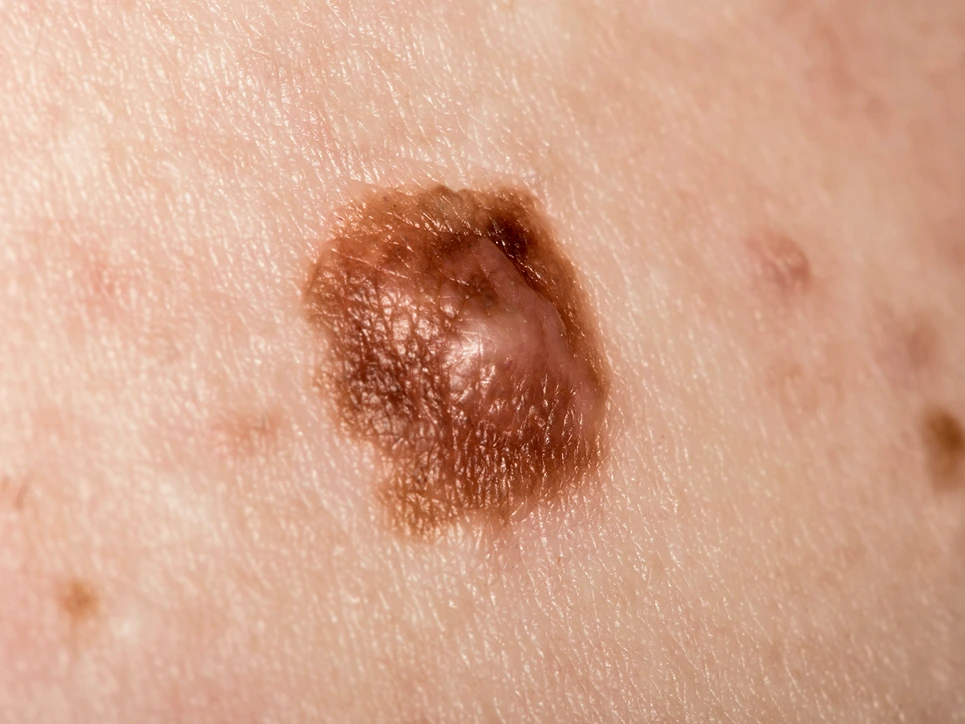

Navigating treatment for metastatic melanoma can be overwhelming. If you or a loved one has been diagnosed with advanced skin cancer, you likely have questions about whether Mohs surgery is an appropriate option.
At Dermatology and Skin Health, we want to help you understand the potential role of Mohs in a comprehensive treatment plan for metastatic disease. We’ll provide an overview of what Mohs surgery is, its advantages and limitations for different types of melanoma, and how it can be coordinated with other therapies when appropriate.
Yes, Mohs is well-suited for removing deeper skin cancers like infiltrative basal cell carcinoma or advanced, thick melanomas. The layer-by-layer approach allows the surgeon to progressively work down and remove cancerous tissue within the deep dermis or subcutaneous fat. Complete margin analysis helps ensure no deep roots of melanoma are left intact.
According to our experience, Mohs achieves high cure rates comparable to other treatments for larger, deep-penetrating skin cancers. The depth the surgeon can reach depends on factors like the tumor’s location and the patient’s overall health. Lesions deep within the facial area near nerves, eyes or blood vessels can be more complex.
When used for especially deep melanomas, Mohs excision is often followed by reconstructive surgery and additional treatment to reduce recurrence risks. But it can successfully remove the detectable cancer within deep skin structures.
The success of Mohs surgery in treating melanoma is backed by several landmark studies comprising more than 6,000 patients over the past 10 years, showing a tumor cure rate of 99.5% to 99.8%.
Mohs surgery has a high cure rate, with up to 99% for skin cancer that has not been treated before and up to 94% for skin cancer that has recurred after previous treatment.
The procedure allows for the removal of all cancerous cells while sparing healthy tissue, leaving the smallest possible scar.
One of the advantages of Mohs surgery is that you know your results right away. You usually don't leave your appointment until all of the skin cancer has been removed.
Mohs surgery is considered an efficient, cost-effective treatment. It is typically performed as a single-visit outpatient surgery under local anesthesia.
An NCBI study concludes that Mohs micrographic surgery (MMS) is equivalent in cost to excision with permanent sections, 12% less costly than office-based excision with frozen sections, and 27% less costly than excision with frozen sections in an ambulatory surgical center (ASC)
The physician examines 100% of tumor margins, which ensures that all cancerous cells are removed. One study states that sectioning the tissue in a horizontal direction allows virtually 100% of the tissue margin (peripheral and deep margins) to be examined under the microscope
Mohs surgery is used less frequently for melanoma because melanoma is far more aggressive and likely to spread than other types of skin cancer.
Doctors fear missing microscopic melanoma cells that could end up spreading throughout the body.
Mohs surgery requires a team of pathologists trained in diagnosing melanoma in frozen sections.
Because of these limitations, adoption is low.
Problems that can occur during and after Mohs surgery include bleeding, pain or tenderness around the places where surgery was done, infection, and temporary or permanent numbness of the surgical area.
The procedure can be time-consuming as it involves the removal of one layer of skin at a time, followed by lab work to examine the removed tissue. This cycle continues until no more cancer cells are found.
The same study on NCBI Bookshelf reveals that the process involves removing a thin margin of tissue around and deep to the clinical margins of a skin tumor, which is then rapidly frozen and sectioned in a cryostat microtome, allowing for quick tissue processing (about 15 to 30 minutes). However, this cycle continues until no more cancer cells are found, which can be time-consuming.
So while Mohs has benefits, it’s crucial to understand its limitations with advanced melanoma. Keep these points in mind when weighing your decision:
According to our experience, the benefits of Mohs for metastatic disease must outweigh these limitations based on the specifics of each unique case. It's most suitable when combined with systemic treatments.

For metastatic melanoma that has spread extensively, Mohs is rarely used as the sole treatment method. Once melanoma has metastasized to multiple distant sites, surgery alone cannot eliminate every cancer cell from the body.
However, Mohs still plays an important role. According to our experience, it can be used to remove visible metastases on the skin before starting other treatments. For example, eliminating surface metastatic legion on the skin can help reduce tumor burden and control symptoms.
One case study reported a patient with a solitary cutaneous metastasis of renal cell carcinoma (RCC) that was successfully treated with Mohs micrographic surgery. The patient showed no recurrence of the lesion after two years of follow-up, suggesting that Mohs surgery can be effective in removing isolated cutaneous metastases.
Mohs surgery can also be used to remove recurrent skin tumors that develop after immunotherapy or chemotherapy. A review of guidelines for Mohs surgery for the treatment of skin cancer indicated that compared with conventional surgical excision, Mohs micrographic surgery led to a significantly higher cure rate for treatment of recurrent non-melanoma skin cancers.
In addition, Mohs surgery can be used in conjunction with other treatments to maximize the odds of long-term remission. For instance, a study on the treatment of locally advanced basal cell carcinoma suggested that Mohs surgery could be part of a multi-disciplinary approach, where different treatment modalities including surgery, radiation therapy, and immunotherapy can be considered.
Yes, when melanoma has extensively metastasized, Mohs is typically one piece of a multifaceted treatment plan. Depending on the details of each case, other options may include:
Based on our experience, the most effective approach against metastatic skin cancer involves carefully coordinated surgical, systemic, and palliative therapies customized to the patient’s disease characteristics and treatment goals.
Mohs surgery focuses on analyzing the margins of removed skin tissue. It does not directly examine lymph nodes and therefore has limited utility for detecting lymph cancer. According to our experience, a sentinel lymph node biopsy is preferred for evaluating lymph nodes for melanoma.
In the context of melanoma, a type of skin cancer, a sentinel lymph node biopsy (SLNB) is often preferred for evaluating lymph nodes, as explained in an article by Cancer Research UK. A SLNB is a test to find the first lymph node or nodes that a melanoma may spread to. The doctor then checks to see if this lymph node contains cancer cells.
This procedure is typically performed at the same time as the operation to remove tissue around the melanoma (wide local excision). The most common place that melanoma skin cancer spreads to is the nearby lymph nodes. Therefore, a SLNB is often performed if the doctor wants to check whether the nearby lymph nodes contain cancer cells.
While Mohs surgery may provide clues about local spread to nearby lymphatic channels based on excised tissue, it does not comprehensively stage or assess all lymph nodes. Further imaging and nodal biopsies are necessary to properly evaluate the lymph system if melanoma has grown deep in the skin.
For instance, certain cancers such as Merkel cell carcinoma can have negative microscopic margins despite residual cancer cells being left behind because MCC often "skips" via local lymphatics to adjacent areas and does not grow a single continuous mass.
Therefore, a sentinel lymph node biopsy almost always needs to be done at a separate appointment (prior to having the cancer fully removed by Mohs surgery), which can make scheduling inconvenient.

We hope this provides helpful insights into the appropriate uses, benefits and limits of Mohs surgery for metastatic melanoma. If you’ve been diagnosed with advanced skin cancer, we encourage you to thoroughly discuss all your treatment options with an experienced melanoma specialist.
At Dermatology and Skin Health, our fellowship-trained Mohs surgeon Dr. Mendese has extensive expertise using Mohs surgery alongside other cutting-edge treatments to maximize results for melanoma patients.
If your desired appointment type or preferred provider is unavailable online, kindly call (978) 525-0100 for Peabody, MA and (603) 742-5556 for all New Hampshire locations. Alternatively please feel free to send us your request via the patient portal, or via email at info@dermskinhealth.com
*For medical dermatology appointments in MA please dial (978) 525-0100 or fill out the appointment request form above.